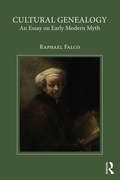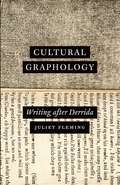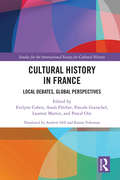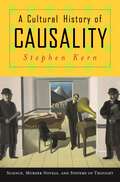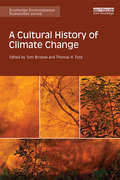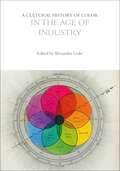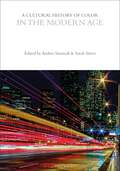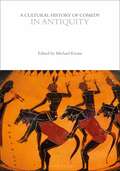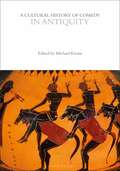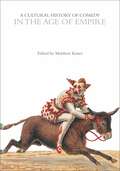- Table View
- List View
Cultural Genealogy: An Essay on Early Modern Myth
by Raphael FalcoCultural Genealogy explores the popularization in the Renaissance of the still pervasive myth that later cultures are the hereditary descendants of ancient or older cultures. The core of this myth is the widespread belief that a numinous charismatic power can be passed down unchanged, and in concrete forms, from earlier eras. Raphael Falco shows that such a process of descent is an impossible illusion in a knowledge-based culture. Anachronistic adoption of past values can only occur when these values are adapted and assimilated to the target culture. Without such transcultural adaptation, ancient values would appear as alien artifacts rather than as eternal truths. Scholars have long acknowledged the Renaissance borrowings from classical antiquity, but most studies of translatio studii or translatio imperii tacitly accept the early modern myth that there was a genuine translation of Greek and Roman cultural values from the ancient world to the "modern." But as Falco demonstrates, this is patently not the case. The mastering of ancient languages and the rediscovery of lost texts has masked the fact that surprisingly little of ancient religious, ethical, or political ideology was retained — so little that it is crucial to ask why these myths of transcultural descent have not been recognized and interrogated. Through examples ranging from Petrarch to Columbus, Maffeo Vegio to the Habsburgs, Falco shows how the new techne of systematic genealogy facilitated the process of "remythicizing" the ancient authorities, utterly transforming Greek and Roman values and reforging them into the mold of contemporary needs. Chiefly a study of intellectual culture, Cultural Genealogy has ramifications reaching into all levels of society, both early modern and later.
Cultural Genealogy: An Essay on Early Modern Myth
by Raphael FalcoCultural Genealogy explores the popularization in the Renaissance of the still pervasive myth that later cultures are the hereditary descendants of ancient or older cultures. The core of this myth is the widespread belief that a numinous charismatic power can be passed down unchanged, and in concrete forms, from earlier eras. Raphael Falco shows that such a process of descent is an impossible illusion in a knowledge-based culture. Anachronistic adoption of past values can only occur when these values are adapted and assimilated to the target culture. Without such transcultural adaptation, ancient values would appear as alien artifacts rather than as eternal truths. Scholars have long acknowledged the Renaissance borrowings from classical antiquity, but most studies of translatio studii or translatio imperii tacitly accept the early modern myth that there was a genuine translation of Greek and Roman cultural values from the ancient world to the "modern." But as Falco demonstrates, this is patently not the case. The mastering of ancient languages and the rediscovery of lost texts has masked the fact that surprisingly little of ancient religious, ethical, or political ideology was retained — so little that it is crucial to ask why these myths of transcultural descent have not been recognized and interrogated. Through examples ranging from Petrarch to Columbus, Maffeo Vegio to the Habsburgs, Falco shows how the new techne of systematic genealogy facilitated the process of "remythicizing" the ancient authorities, utterly transforming Greek and Roman values and reforging them into the mold of contemporary needs. Chiefly a study of intellectual culture, Cultural Genealogy has ramifications reaching into all levels of society, both early modern and later.
Cultural Graphology: Writing after Derrida
by Juliet Fleming“Cultural Graphology” could be the name of a new human science: this was Derrida’s speculation when, in the late 1960s, he imagined a discipline that combined psychoanalysis, deconstruction, and a commitment to the topic of writing. He never undertook the project himself but did leave two brief sketches of how he thought cultural graphology might proceed. In this book, Juliet Fleming picks up where Derrida left off. Using both his early and later thought, and the psychoanalytic texts to which it is addressed, to examine the print culture of early modern England, she drastically unsettles some key assumptions of book history. Fleming shows that the single most important lesson to survive from Derrida’s early work is that we do not know what writing is. Channeling Derrida’s thought into places it has not been seen before, she examines printed errors, spaces, and ornaments (topics that have hitherto been marginal to our accounts of print culture) and excavates the long-forgotten reading practice of cutting printed books. Proposing radical deformations to the meanings of fundamental and apparently simple terms such as “error,” “letter,” “surface,” and “cut,” Fleming opens up exciting new pathways into our understanding of writing all told.
Cultural Graphology: Writing after Derrida
by Juliet Fleming“Cultural Graphology” could be the name of a new human science: this was Derrida’s speculation when, in the late 1960s, he imagined a discipline that combined psychoanalysis, deconstruction, and a commitment to the topic of writing. He never undertook the project himself but did leave two brief sketches of how he thought cultural graphology might proceed. In this book, Juliet Fleming picks up where Derrida left off. Using both his early and later thought, and the psychoanalytic texts to which it is addressed, to examine the print culture of early modern England, she drastically unsettles some key assumptions of book history. Fleming shows that the single most important lesson to survive from Derrida’s early work is that we do not know what writing is. Channeling Derrida’s thought into places it has not been seen before, she examines printed errors, spaces, and ornaments (topics that have hitherto been marginal to our accounts of print culture) and excavates the long-forgotten reading practice of cutting printed books. Proposing radical deformations to the meanings of fundamental and apparently simple terms such as “error,” “letter,” “surface,” and “cut,” Fleming opens up exciting new pathways into our understanding of writing all told.
Cultural Graphology: Writing after Derrida
by Juliet Fleming“Cultural Graphology” could be the name of a new human science: this was Derrida’s speculation when, in the late 1960s, he imagined a discipline that combined psychoanalysis, deconstruction, and a commitment to the topic of writing. He never undertook the project himself but did leave two brief sketches of how he thought cultural graphology might proceed. In this book, Juliet Fleming picks up where Derrida left off. Using both his early and later thought, and the psychoanalytic texts to which it is addressed, to examine the print culture of early modern England, she drastically unsettles some key assumptions of book history. Fleming shows that the single most important lesson to survive from Derrida’s early work is that we do not know what writing is. Channeling Derrida’s thought into places it has not been seen before, she examines printed errors, spaces, and ornaments (topics that have hitherto been marginal to our accounts of print culture) and excavates the long-forgotten reading practice of cutting printed books. Proposing radical deformations to the meanings of fundamental and apparently simple terms such as “error,” “letter,” “surface,” and “cut,” Fleming opens up exciting new pathways into our understanding of writing all told.
Cultural Graphology: Writing after Derrida
by Juliet Fleming“Cultural Graphology” could be the name of a new human science: this was Derrida’s speculation when, in the late 1960s, he imagined a discipline that combined psychoanalysis, deconstruction, and a commitment to the topic of writing. He never undertook the project himself but did leave two brief sketches of how he thought cultural graphology might proceed. In this book, Juliet Fleming picks up where Derrida left off. Using both his early and later thought, and the psychoanalytic texts to which it is addressed, to examine the print culture of early modern England, she drastically unsettles some key assumptions of book history. Fleming shows that the single most important lesson to survive from Derrida’s early work is that we do not know what writing is. Channeling Derrida’s thought into places it has not been seen before, she examines printed errors, spaces, and ornaments (topics that have hitherto been marginal to our accounts of print culture) and excavates the long-forgotten reading practice of cutting printed books. Proposing radical deformations to the meanings of fundamental and apparently simple terms such as “error,” “letter,” “surface,” and “cut,” Fleming opens up exciting new pathways into our understanding of writing all told.
Cultural Graphology: Writing after Derrida
by Juliet Fleming“Cultural Graphology” could be the name of a new human science: this was Derrida’s speculation when, in the late 1960s, he imagined a discipline that combined psychoanalysis, deconstruction, and a commitment to the topic of writing. He never undertook the project himself but did leave two brief sketches of how he thought cultural graphology might proceed. In this book, Juliet Fleming picks up where Derrida left off. Using both his early and later thought, and the psychoanalytic texts to which it is addressed, to examine the print culture of early modern England, she drastically unsettles some key assumptions of book history. Fleming shows that the single most important lesson to survive from Derrida’s early work is that we do not know what writing is. Channeling Derrida’s thought into places it has not been seen before, she examines printed errors, spaces, and ornaments (topics that have hitherto been marginal to our accounts of print culture) and excavates the long-forgotten reading practice of cutting printed books. Proposing radical deformations to the meanings of fundamental and apparently simple terms such as “error,” “letter,” “surface,” and “cut,” Fleming opens up exciting new pathways into our understanding of writing all told.
Cultural Graphology: Writing after Derrida
by Juliet Fleming“Cultural Graphology” could be the name of a new human science: this was Derrida’s speculation when, in the late 1960s, he imagined a discipline that combined psychoanalysis, deconstruction, and a commitment to the topic of writing. He never undertook the project himself but did leave two brief sketches of how he thought cultural graphology might proceed. In this book, Juliet Fleming picks up where Derrida left off. Using both his early and later thought, and the psychoanalytic texts to which it is addressed, to examine the print culture of early modern England, she drastically unsettles some key assumptions of book history. Fleming shows that the single most important lesson to survive from Derrida’s early work is that we do not know what writing is. Channeling Derrida’s thought into places it has not been seen before, she examines printed errors, spaces, and ornaments (topics that have hitherto been marginal to our accounts of print culture) and excavates the long-forgotten reading practice of cutting printed books. Proposing radical deformations to the meanings of fundamental and apparently simple terms such as “error,” “letter,” “surface,” and “cut,” Fleming opens up exciting new pathways into our understanding of writing all told.
Cultural Heritage and the Literary Archive: Objects, Institutions, and Practices between the Analogue and the Digital (Routledge Interdisciplinary Perspectives on Literature)
by Tim SommerModern literary archives play a key role in how authors’ lives and works get canonized and consecrated as cultural heritage. This interdisciplinary volume combines literary studies, book history, textual criticism, heritage studies, archival theory, and the digital humanities to examine the past, present, and future of literary archiving. Featuring contributions from leading international scholars and archive professionals, the book explores the objects, practices, and institutions that have been at the heart of the modern archival landscape since its emergence in the nineteenth century. Covering a wide range of questions, the volume reconstructs how literary manuscripts turned into secular relics and analyzes the impact that the rise of the archive has had on the scholarly study and public perception of literature as cultural heritage. Individual chapters range from historical accounts of the Romantic origins of manuscript worship to critical discussions of the archiving of contemporary writers’ born-digital material.
Cultural Heritage and the Literary Archive: Objects, Institutions, and Practices between the Analogue and the Digital (Routledge Interdisciplinary Perspectives on Literature)
Modern literary archives play a key role in how authors’ lives and works get canonized and consecrated as cultural heritage. This interdisciplinary volume combines literary studies, book history, textual criticism, heritage studies, archival theory, and the digital humanities to examine the past, present, and future of literary archiving. Featuring contributions from leading international scholars and archive professionals, the book explores the objects, practices, and institutions that have been at the heart of the modern archival landscape since its emergence in the nineteenth century. Covering a wide range of questions, the volume reconstructs how literary manuscripts turned into secular relics and analyzes the impact that the rise of the archive has had on the scholarly study and public perception of literature as cultural heritage. Individual chapters range from historical accounts of the Romantic origins of manuscript worship to critical discussions of the archiving of contemporary writers’ born-digital material.
Cultural History in France: Local Debates, Global Perspectives (Studies for the International Society for Cultural History)
by Evelyne Cohen Anaïs Fléchet Pascale Goetschel Laurent Martin Pascal OryThis volume, which gathers contributions presented at the annual conferences of l'Association pour le développement de l'histoire culturelle (ADHC), questions the subjects and boundaries of cultural history in France – with regard to neighboring approaches such as cultural studies, media studies, and gender studies – to elaborate a "social history of representations." Historians, philosophers and sociologists address a large variety of topics and methodological proposals. Definitions, objects and actors, memories and cultural transfers: this book depicts the major questions that underlie the historical debate at the beginning of the 21st century.
Cultural History in France: Local Debates, Global Perspectives (Studies for the International Society for Cultural History)
by Evelyne Cohen Anaïs Fléchet Pascale Gœtschel Laurent Martin Pascal Ory Andrew Hill Rosine FefermanThis volume, which gathers contributions presented at the annual conferences of l'Association pour le développement de l'histoire culturelle (ADHC), questions the subjects and boundaries of cultural history in France – with regard to neighboring approaches such as cultural studies, media studies, and gender studies – to elaborate a "social history of representations." Historians, philosophers and sociologists address a large variety of topics and methodological proposals. Definitions, objects and actors, memories and cultural transfers: this book depicts the major questions that underlie the historical debate at the beginning of the 21st century.
A Cultural History of Causality: Science, Murder Novels, and Systems of Thought
by Stephen KernThis pioneering work is the first to trace how our understanding of the causes of human behavior has changed radically over the course of European and American cultural history since 1830. Focusing on the act of murder, as documented vividly by more than a hundred novels including Crime and Punishment, An American Tragedy, The Trial, and Lolita, Stephen Kern devotes each chapter of A Cultural History of Causality to examining a specific causal factor or motive for murder--ancestry, childhood, language, sexuality, emotion, mind, society, and ideology. In addition to drawing on particular novels, each chapter considers the sciences (genetics, endocrinology, physiology, neuroscience) and systems of thought (psychoanalysis, linguistics, sociology, forensic psychiatry, and existential philosophy) most germane to each causal factor or motive. Kern identifies five shifts in thinking about causality, shifts toward increasing specificity, multiplicity, complexity, probability, and uncertainty. He argues that the more researchers learned about the causes of human behavior, the more they realized how much more there was to know and how little they knew about what they thought they knew. The book closes by considering the revolutionary impact of quantum theory, which, though it influenced novelists only marginally, shattered the model of causal understanding that had dominated Western thought since the seventeenth century. Others have addressed changing ideas about causality in specific areas, but no one has tackled a broad cultural history of this concept as does Stephen Kern in this engagingly written and lucidly argued book.
A Cultural History of Causality: Science, Murder Novels, and Systems of Thought (PDF)
by Stephen KernThis pioneering work is the first to trace how our understanding of the causes of human behavior has changed radically over the course of European and American cultural history since 1830. Focusing on the act of murder, as documented vividly by more than a hundred novels including Crime and Punishment, An American Tragedy, The Trial, and Lolita, Stephen Kern devotes each chapter of A Cultural History of Causality to examining a specific causal factor or motive for murder--ancestry, childhood, language, sexuality, emotion, mind, society, and ideology. In addition to drawing on particular novels, each chapter considers the sciences (genetics, endocrinology, physiology, neuroscience) and systems of thought (psychoanalysis, linguistics, sociology, forensic psychiatry, and existential philosophy) most germane to each causal factor or motive. Kern identifies five shifts in thinking about causality, shifts toward increasing specificity, multiplicity, complexity, probability, and uncertainty. He argues that the more researchers learned about the causes of human behavior, the more they realized how much more there was to know and how little they knew about what they thought they knew. The book closes by considering the revolutionary impact of quantum theory, which, though it influenced novelists only marginally, shattered the model of causal understanding that had dominated Western thought since the seventeenth century. Others have addressed changing ideas about causality in specific areas, but no one has tackled a broad cultural history of this concept as does Stephen Kern in this engagingly written and lucidly argued book.
A Cultural History of Climate Change (Routledge Environmental Humanities)
by Tom Bristow Thomas H. FordCharting innovative directions in the environmental humanities, this book examines the cultural history of climate change under three broad headings: history, writing and politics. Climate change compels us to rethink many of our traditional means of historical understanding, and demands new ways of relating human knowledge, action and representations to the dimensions of geological and evolutionary time. To address these challenges, this book positions our present moment of climatic knowledge within much longer histories of climatic experience. Only in light of these histories, it argues, can we properly understand what climate means today across an array of discursive domains, from politics, literature and law to neighbourly conversation. Its chapters identify turning-points and experiments in the construction of climates and of atmospheres of sensation. They examine how contemporary ecological thought has repoliticised the representation of nature and detail vital aspects of the history and prehistory of our climatic modernity. This ground-breaking text will be of great interest to researchers and postgraduate students in environmental history, environmental governance, history of ideas and science, literature and eco-criticism, political theory, cultural theory, as well as all general readers interested in climate change.
A Cultural History of Climate Change (Routledge Environmental Humanities)
by Tom Bristow Thomas H. FordCharting innovative directions in the environmental humanities, this book examines the cultural history of climate change under three broad headings: history, writing and politics. Climate change compels us to rethink many of our traditional means of historical understanding, and demands new ways of relating human knowledge, action and representations to the dimensions of geological and evolutionary time. To address these challenges, this book positions our present moment of climatic knowledge within much longer histories of climatic experience. Only in light of these histories, it argues, can we properly understand what climate means today across an array of discursive domains, from politics, literature and law to neighbourly conversation. Its chapters identify turning-points and experiments in the construction of climates and of atmospheres of sensation. They examine how contemporary ecological thought has repoliticised the representation of nature and detail vital aspects of the history and prehistory of our climatic modernity. This ground-breaking text will be of great interest to researchers and postgraduate students in environmental history, environmental governance, history of ideas and science, literature and eco-criticism, political theory, cultural theory, as well as all general readers interested in climate change.
A Cultural History of Color in the Age of Enlightenment (The Cultural Histories Series)
by Carole P. Biggam and Kirsten WolfA Cultural History of Color in the Age of Enlightenment covers the period 1650 to 1800. From the Baroque to the Neo-classical, color transformed art, architecture, ceramics, jewelry, and glass. Newton, using a prism, demonstrated the seven separate hues, which encouraged the development of color wheels and tables, and the increased standardization of color names. Technological advances in color printing resulted in superb maps and anatomical and botanical images. Identity and wealth were signalled with color, in uniforms, flags, and fashion. And the growth of empires, trade, and slavery encouraged new ideas about color.Color shapes an individual's experience of the world and also how society gives particular spaces, objects, and moments meaning. The 6 volume set of the Cultural History of Color examines how color has been created, traded, used, and interpreted over the last 5000 years. The themes covered in each volume are color philosophy and science; color technology and trade; power and identity; religion and ritual; body and clothing; language and psychology; literature and the performing arts; art; architecture and interiors; and artefacts.Carole P. Biggam is Honorary Senior Research Fellow in English Language and Linguistics at the University of Glasgow, UK. Kirsten Wolf is Professor of Old Norse and Scandinavian Linguistics at the University of Wisconsin-Madison, USA.Volume 4 in the Cultural History of Color set.General Editors: Carole P. Biggam and Kirsten Wolf
A Cultural History of Color in the Age of Enlightenment (The Cultural Histories Series)
A Cultural History of Color in the Age of Enlightenment covers the period 1650 to 1800. From the Baroque to the Neo-classical, color transformed art, architecture, ceramics, jewelry, and glass. Newton, using a prism, demonstrated the seven separate hues, which encouraged the development of color wheels and tables, and the increased standardization of color names. Technological advances in color printing resulted in superb maps and anatomical and botanical images. Identity and wealth were signalled with color, in uniforms, flags, and fashion. And the growth of empires, trade, and slavery encouraged new ideas about color.Color shapes an individual's experience of the world and also how society gives particular spaces, objects, and moments meaning. The 6 volume set of the Cultural History of Color examines how color has been created, traded, used, and interpreted over the last 5000 years. The themes covered in each volume are color philosophy and science; color technology and trade; power and identity; religion and ritual; body and clothing; language and psychology; literature and the performing arts; art; architecture and interiors; and artefacts.Carole P. Biggam is Honorary Senior Research Fellow in English Language and Linguistics at the University of Glasgow, UK. Kirsten Wolf is Professor of Old Norse and Scandinavian Linguistics at the University of Wisconsin-Madison, USA.Volume 4 in the Cultural History of Color set.General Editors: Carole P. Biggam and Kirsten Wolf
A Cultural History of Color in the Age of Industry (The Cultural Histories Series)
by Alexandra LoskeA Cultural History of Color in the Age of Industry covers the period 1800 to 1920, when the world embraced color like never before. Inventions, such as steam power, lithography, photography, electricity, motor cars, aviation, and cheaper color printing, all contributed to a new exuberance about color. Available pigments and colored products - made possible by new technologies, industrial manufacturing, commercialization, and urbanization – also greatly increased, as did illustrated printed literature for the mass market. Color, both literally and metaphorically, was splashed around, and became an expressive tool for artists, designers, and writers. Color shapes an individual's experience of the world and also how society gives particular spaces, objects, and moments meaning. The 6 volume set of the Cultural History of Color examines how color has been created, traded, used, and interpreted over the last 5000 years. The themes covered in each volume are color philosophy and science; color technology and trade; power and identity; religion and ritual; body and clothing; language and psychology; literature and the performing arts; art; architecture and interiors; and artefacts. Alexandra Loske is Curator at the Royal Pavilion and Museums, Brighton, UK Volume 5 in the Cultural History of Color set. General Editors: Carole P. Biggam and Kirsten Wolf
A Cultural History of Color in the Age of Industry (The Cultural Histories Series)
A Cultural History of Color in the Age of Industry covers the period 1800 to 1920, when the world embraced color like never before. Inventions, such as steam power, lithography, photography, electricity, motor cars, aviation, and cheaper color printing, all contributed to a new exuberance about color. Available pigments and colored products - made possible by new technologies, industrial manufacturing, commercialization, and urbanization – also greatly increased, as did illustrated printed literature for the mass market. Color, both literally and metaphorically, was splashed around, and became an expressive tool for artists, designers, and writers. Color shapes an individual's experience of the world and also how society gives particular spaces, objects, and moments meaning. The 6 volume set of the Cultural History of Color examines how color has been created, traded, used, and interpreted over the last 5000 years. The themes covered in each volume are color philosophy and science; color technology and trade; power and identity; religion and ritual; body and clothing; language and psychology; literature and the performing arts; art; architecture and interiors; and artefacts. Alexandra Loske is Curator at the Royal Pavilion and Museums, Brighton, UK Volume 5 in the Cultural History of Color set. General Editors: Carole P. Biggam and Kirsten Wolf
A Cultural History of Color in the Modern Age (The Cultural Histories Series)
by Anders Steinvall and Sarah StreetA Cultural History of Color in the Modern Age covers the period 1920 to the present, a time of extraordinary developments in colour science, philosophy, art, design and technologies. The expansion of products produced with synthetic dyes was accelerated by mass consumerism as artists, designers, architects, writers, theater and filmmakers made us a 'color conscious' society. This influenced what we wore, how we chose to furnish and decorate our homes, and how we responded to the vibrancy and chromatic eclecticism of contemporary visual cultures.The volume brings together research on how philosophers, scientists, linguists and artists debated color's polyvalence, its meaning to different cultures, and how it could be measured, manufactured, manipulated and enjoyed. Color shapes an individual's experience of the world and also how society gives particular spaces, objects, and moments meaning. The 6 volume set of the Cultural History of Color examines how color has been created, traded, used, and interpreted over the last 5000 years. The themes covered in each volume are color philosophy and science; color technology and trade; power and identity; religion and ritual; body and clothing; language and psychology; literature and the performing arts; art; architecture and interiors; and artefacts. Anders Steinvall is Senior Lecturer in English Linguistics at Umeå University, Sweden. Sarah Street is Professor of Film at the University of Bristol, UK. Volume 6 in the Cultural History of Color set. General Editors: Carole P. Biggam and Kirsten Wolf
A Cultural History of Color in the Modern Age (The Cultural Histories Series)
A Cultural History of Color in the Modern Age covers the period 1920 to the present, a time of extraordinary developments in colour science, philosophy, art, design and technologies. The expansion of products produced with synthetic dyes was accelerated by mass consumerism as artists, designers, architects, writers, theater and filmmakers made us a 'color conscious' society. This influenced what we wore, how we chose to furnish and decorate our homes, and how we responded to the vibrancy and chromatic eclecticism of contemporary visual cultures.The volume brings together research on how philosophers, scientists, linguists and artists debated color's polyvalence, its meaning to different cultures, and how it could be measured, manufactured, manipulated and enjoyed. Color shapes an individual's experience of the world and also how society gives particular spaces, objects, and moments meaning. The 6 volume set of the Cultural History of Color examines how color has been created, traded, used, and interpreted over the last 5000 years. The themes covered in each volume are color philosophy and science; color technology and trade; power and identity; religion and ritual; body and clothing; language and psychology; literature and the performing arts; art; architecture and interiors; and artefacts. Anders Steinvall is Senior Lecturer in English Linguistics at Umeå University, Sweden. Sarah Street is Professor of Film at the University of Bristol, UK. Volume 6 in the Cultural History of Color set. General Editors: Carole P. Biggam and Kirsten Wolf
A Cultural History of Comedy in Antiquity (The Cultural Histories Series)
by Andrew McConnell Stott Eric WeitzDrawing together contributions from scholars in a wide range of fields inside Classics and Drama, this volume traces the development of comedic performance and examines the different characteristics of Greek and Roman comedy. Although the origins of comedy are obscure, this study argues that comedic performances were at the heart of Graeco-Roman culture from around 486 BCE to the mid first century BCE. It explores the range of comedies during this period, which were fictional dramas that engaged with the political and social concerns of ancient society, and also at times with mythology and tragedy.The volume centres largely around the surviving work of Aristophanes and Menander in Athens, and Plautus and Terence in Rome, but authors whose plays survive only in fragments are also discussed. Performances and plays drew on a range of forms, including satire and fantasy, and were designed to entertain and amuse their audiences while also asking them to question issues of morality, privilege and class. Each chapter takes a different theme as its focus: form, theory, praxis, identities, the body, politics and power, laughter and ethics. These eight different approaches to ancient comedy add up to an extensive, synoptic coverage of the subject.
A Cultural History of Comedy in Antiquity (The Cultural Histories Series)
by Andrew McConnell Stott Eric WeitzDrawing together contributions from scholars in a wide range of fields inside Classics and Drama, this volume traces the development of comedic performance and examines the different characteristics of Greek and Roman comedy. Although the origins of comedy are obscure, this study argues that comedic performances were at the heart of Graeco-Roman culture from around 486 BCE to the mid first century BCE. It explores the range of comedies during this period, which were fictional dramas that engaged with the political and social concerns of ancient society, and also at times with mythology and tragedy.The volume centres largely around the surviving work of Aristophanes and Menander in Athens, and Plautus and Terence in Rome, but authors whose plays survive only in fragments are also discussed. Performances and plays drew on a range of forms, including satire and fantasy, and were designed to entertain and amuse their audiences while also asking them to question issues of morality, privilege and class. Each chapter takes a different theme as its focus: form, theory, praxis, identities, the body, politics and power, laughter and ethics. These eight different approaches to ancient comedy add up to an extensive, synoptic coverage of the subject.
A Cultural History of Comedy in the Age of Empire (The Cultural Histories Series)
by Eric Weitz Andrew McConnell StottDrawing together contributions from scholars in a range of fields within 19th- and 20th-century cultural, literary, and theater studies, this volume provides a thorough and varied overview of the many forms comedy took in the 19th century. Given the earth-shattering cultural changes and political events that mark the decades between 1800 and 1920-shifting borders, socioeconomic upheaval, scientific and technological innovation, the rise of consumerism and mass culture, unprecedented overseas expansion by European and American imperial powers-it is no wonder that people in the Age of Empire turned to comedy in order to make sense of the contradictions that structure modern identity and navigate the sociocultural fault lines within modern life. Comical, humorous, and satirical cultural artifacts from the period capture the anxieties and aspirations, the petty resentments and lofty ideals, of a world buffeted by change. This volume explores the aesthetic, political, and ethical dimensions of comedy in the context of blackface minstrelsy, nonsense poetry, music hall and pantomime, comic almanacs and joke books, journalism, silent film, popular novels, and hygiene magazines, among other phenomena. It also provides a detailed account of contentious debates among social Darwinists, psychoanalysts, and political philosophers about the meaning and significance of comedy and laughter to human life.Each chapter takes a different theme as its focus: form, theory, praxis, identity, the body, politics and power, laughter, and ethics. These eight divergent approaches to comedy in the Age of Empire add up to an extensive, synoptic coverage of the subject.
